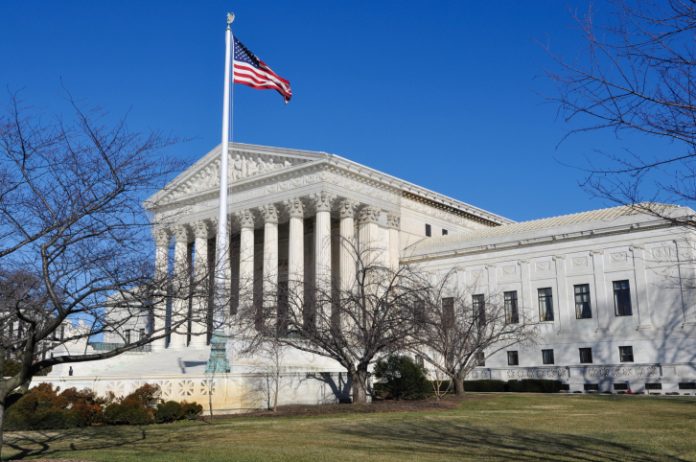On Thursday, the U.S. Supreme Court issued the greatest majority opinion ever written by Chief Justice John G. Roberts. That one-time Obamacare savior, who in 2012 rewrote the Affordable Care Act’s individual mandate as a “tax” in order to salvage President Barack Obama’s signature domestic policy, this time penned a landmark ruling abolishing something the Left has been clamoring to abolish ever since the 2020 death of George Floyd and the subsequent “Great Awokening” that rocked the republic: “systemic racism” in America.
Oh, that wasn’t the way Thursday’s huge news was framed by MSNBC talking heads and New York Times editorialists? Curious, that.
It is true that the corporate media headlines emanating from Thursday’s consolidated opinion in this term’s twin affirmative action cases, Students for Fair Admissions (SFFA) v. Harvard College and SFFA v. University of North Carolina, would have you believe that the Court did something closely approximating the opposite of ending so-called “systemic racism” in America. Those wokesters, “identity politics” enthusiasts, Ibram X. Kendi-esque “anti-racism” proponents, Al Sharpton-style race hustlers, and the addlebrained president of the United States himself would all instead have us believe that a far-right, reactionary cabal of jurisprudential troglodytes on the High Court “set us back” on the issue of race. According to this popular narrative, the SFFA opinion is positively nightmarish; John Roberts might as well be a reincarnation of Roger Taney.
The fact that such a narrative exists — indeed, that it is so popular — says a great deal about the woeful state of intellectual honesty, and indeed basic ethical decency, on the American Left. (That very much includes the two vociferous dissenters in SFFA, Justices Sonia Sotomayor and Ketanji Brown Jackson.)
The outcome of SFFA, which mercifully overturns the Court’s muddled mess of affirmative action precedents going back four and a half decades, is every bit as much a vindication of the U.S. Constitution’s colorblindness as was last century’s epochal desegregation ruling in Brown v. Board of Education. The “sordid business” of race-conscious admissions decisions in American universities, to borrow from one of Roberts’ earliest notable writings during his Court tenure (League of United Latin American Citizens v. Perry, in 2006), has been vanquished in the name of the 14th Amendment’s Equal Protection Clause. Even preceding the Constitution, the very equality principle — “We hold these truths to be self-evident …” — of Jefferson’s Declaration itself has been vindicated, as well.
In what world is that fundamentally just result “not” worth celebrating?
Admissions officers at both public and private universities shall never again be legally permitted to explicitly take race into account when they make admissions decisions. If they do so anyway, they will now face personal liability and be subject for monetary damages. Sure, some officers will try to get creative and toe a very careful line, but how far can they really go when it is their own personal savings on the line? And as the chief justice himself clarified, in a delectable shot across the bow fired at Sotomayor and Jackson: “(D)espite the dissent’s assertion to the contrary, universities may not simply establish through application essays or other means the regime we hold unlawful today. (A dissenting opinion is generally not the best source of legal advice on how to comply with the majority opinion.)”
SFFA is also a vindication of Justice Clarence Thomas, the greatest living American, who has been sounding the alarm on the perils of affirmative action for decades. As Thomas has repeatedly pointed out, and which he reiterated in his magisterial SFFA concurrence, the liberals and progressives who seek to “help” black and Hispanic applicants via affirmative action policies oftentimes do the precise opposite of helping them.
First, there is “mismatch theory,” according to which meritocracy-undermining affirmative action policies empirically harm matriculants and set them up for failure by matching them with universities not reflective of their natural skills and aptitudes. Another word for “mismatch theory” is “common sense”: Anyone who has graduated from an elite university with his/her eyes open, and who is not blinded by voguish “anti-racist” dogma, would agree with the basic proposition. Second, and more important, affirmative action policies cast a presumptive badge of inferiority on minority students who “do” matriculate at elite institutions, causing both minority students to doubt themselves and other students to view their peers’ placement there with skepticism.
Ultimately, America can either have “equity,” as modern wokesters use the term, or it can have equality — real moral and legal equality under the rule of law. This is a zero-sum game — only one vision of the American regime can prevail in our roiling, cold civil war. In SFFA, the only one of those two visions that is in line with our nation’s colorblind Founding ideals was the one that prevailed; the impostor race-conscious regime vision, which Democrats have championed as far back as John C. Calhoun’s antebellum defense of the “peculiar institution” as a “positive good,” has suffered yet another grievous blow.
As Thomas, a black man who grew up dirt-poor in the Jim Crow South, concluded in his SFFA concurrence: “While I am painfully aware of the social and economic ravages which have befallen my race and all who suffer discrimination, I hold out enduring hope that this country will live up to its principles so clearly enunciated in the Declaration of Independence and the Constitution of the United States: that all men are created equal, are equal citizens, and must be treated equally before the law.”
In SFFA, the Supreme Court took a giant step toward making Thomas’ “enduring hope” a lived reality. The last trace of genuine, government-legitimized “systemic racism” in America is no more. Good riddance.
To find out more about Josh Hammer and read features by other Creators Syndicate writers and cartoonists, visit the Creators Syndicate website at www.creators.com.
COPYRIGHT 2023 CREATORS.COM
For more great content from Rights, Justice & Culture News.
For more from The Heartland Institute.






